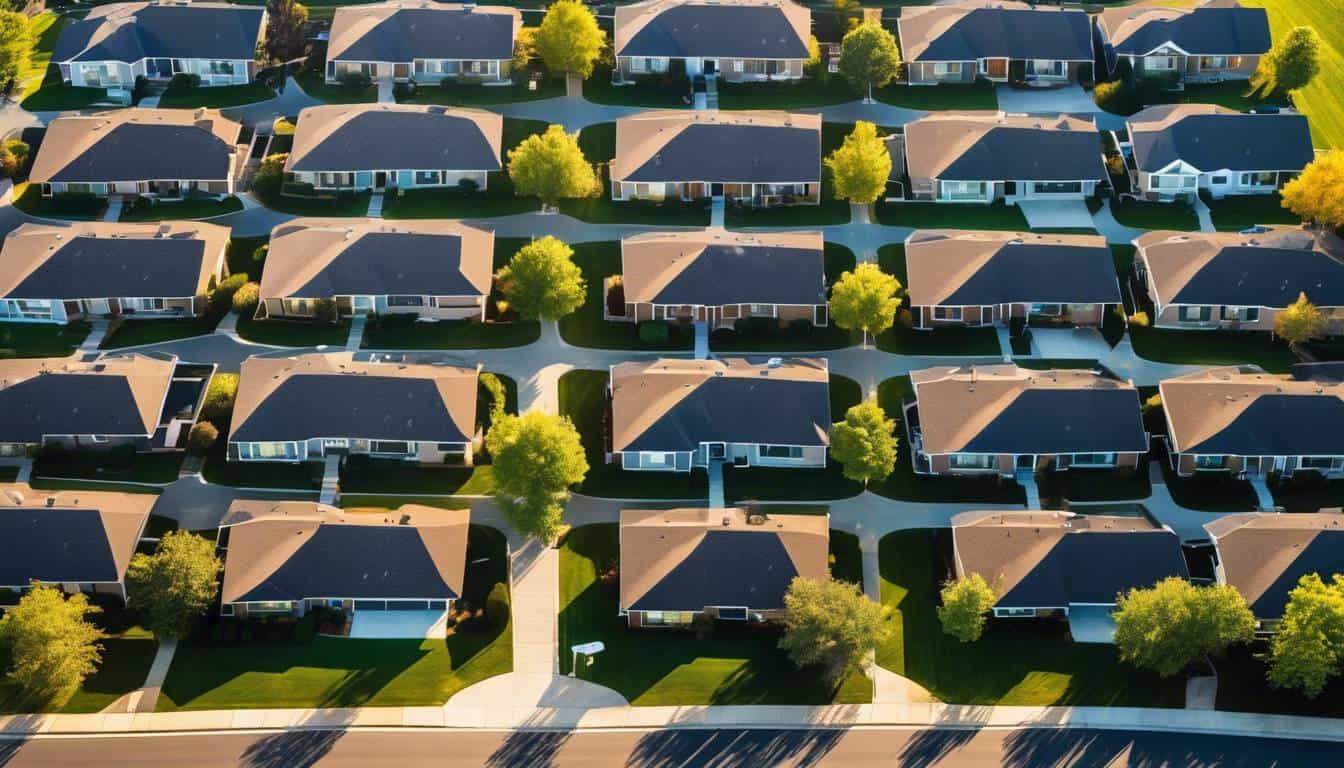The idea of solar panels is amazing… I have been sold on the concept since the 90’s when I first had a solar powered calculator and thought: “Wow, this is so cool”. So how did that translate to having my home powered by solar panels? After all, they don’t just save on energy bills, but significantly reduce your carbon footprint as well – an unexpected bonus in our fight against climate change. Ready to dive into the details? Before we do, it’s worth noting that solar panels are just one way to make your home more energy-efficient. For example, heated floors can also be energy efficient in certain situations, providing another option for eco-conscious homeowners?
Absolutely! Solar panels can significantly reduce your electricity bills while also contributing to a cleaner, more sustainable environment. With various incentives and rebates available, the initial investment in solar panels can lead to substantial long-term savings.
The Science Behind Solar Panels
Have you ever wondered how those sleek black solar panels perched on rooftops are able to harness sunlight and convert it into usable electricity? It’s a truly remarkable process that relies on the principles of the photovoltaic effect. Solar panels, also called photovoltaic (PV) panels, are made up of numerous individual solar cells, which work together to transform sunlight into electrical power through the photovoltaic effect.
The photovoltaic effect is responsible for generating electricity when light interacts with semiconducting materials in the solar cells. When photons from sunlight hit these materials, they transfer their energy to electrons in the atoms of the material, causing them to break free from their atoms. This movement of electrons results in the creation of an electric current. Each solar cell is constructed with layers of silicon, a key semiconductor material renowned for its ability to absorb sunlight efficiently.
This flow of electrons within the solar cell generates direct current (DC) electricity. However, most homes and buildings use alternating current (AC) to power appliances and lighting. To make this electricity compatible with household use, an inverter is employed to convert the DC electricity produced by the solar panels into AC electricity. This allows seamless integration with the electrical grid and everyday household devices.
It’s important to note that this amazing process operates independently from any moving parts or noise, making solar panels an incredibly quiet and low-maintenance source of renewable energy. With no reliance on fuel or extensive mechanical systems, PV panels offer a sustainable and reliable method for generating electricity that is both environmentally friendly and cost-effective.
Solar panels work based on the principles of the photovoltaic effect discovered by Edmond Becquerel in 1839, making them a reliable and sustainable source of energy.
Understanding the intricate science behind solar panels sheds light on their incredible capability to utilize natural sunlight as a clean and renewable energy resource for powering our homes and communities.
Financial and Environmental Advantages of Solar Panels
When making the decision to go solar, the bottom line can often be a deciding factor. What are the financial advantages? Will it save you money in the long run? Let’s break it down. It’s similar to deciding whether to invest in a whole house generator – you need to consider both the upfront costs and long-term savings, as well as the potential energy output and consumption.
Financial Advantages
One of the most appealing aspects of installing solar panels is the prospect of significant long-term cost savings on electricity bills. By generating your own free power from the sun, you rely less on utility companies for your energy needs. As a result, your monthly electricity expenses can drop significantly, and, in some instances, homeowners even receive credit for unused electricity through a program called net metering. This means that excess energy generated by your solar panels can be sold back to the grid, potentially providing additional financial returns.
For many homeowners, this not only offsets their energy costs but also turns their homes into mini power plants that produce an income. Imagine that—getting paid for the extra power that your home produces!
Financial Benefit |
Description |
|---|---|
Long-term Cost Savings |
Reduced electricity bills over time |
Net Metering |
Selling excess energy back to the grid |
Government Incentives |
Tax credits or rebates to offset initial investment |
Now that we’ve seen how solar panels can lead to significant financial savings, let’s also consider the environmental advantages they offer.
Environmental Advantages
Aside from monetary savings, adopting solar energy contributes to important environmental benefits as well. By harnessing renewable energy from the sun, individuals and communities reduce their reliance on non-renewable sources such as coal or natural gas, decreasing carbon emissions and contributing to a healthier environment.
Solar energy is clean and sustainable. It helps decrease our carbon footprint and reduces greenhouse gas emissions.
Think of it this way: Choosing solar energy is like choosing a bicycle over a car for short trips. It’s a cleaner, more sustainable choice that benefits not just you but everyone around you.
According to recent research, if every household in the United States switched to solar power, it would be equivalent to planting 7,709 trees or preventing 8,300 tons of carbon dioxide from being released into the atmosphere.
In essence, embracing solar power is a proactive step toward mitigating climate change and promoting sustainability. With these combined advantages—financial savings and environmental stewardship—solar panels become an attractive and sensible option for homeowners looking toward a cleaner and more cost-effective future.
With a clear view of the financial and environmental benefits of solar panels, let’s now explore the comprehensive cost associated with procuring and installing these systems.
The Comprehensive Cost of Solar Panels
When making the decision to install solar panels, understanding the total cost is crucial. The total expense of a solar panel installation encompasses several components such as labor costs, permits, potential additional electrical work required, and more. These variables collectively determine the final price tag that comes with transitioning to solar energy.
The size of the solar system and the quality of the panels play significant roles in determining the overall cost. A larger system with higher-quality panels generally leads to a higher upfront investment. On the other hand, a smaller system with standard panels may be more budget-friendly at first but could potentially compromise long-term energy efficiency and durability.
Additionally, the location of the installation site can impact the cost. The specifics of each location, such as roof size, orientation, shading, and grid connection, can influence the complexity of the installation process, subsequently affecting the total cost.
Factors influencing Solar Panel Costs
It’s beneficial to consider various factors that can influence the cost of a solar panel installation:
Factor |
Impact |
|---|---|
Panel Quality |
Higher-quality panels contribute to increased upfront costs but may result in greater energy production and longevity. |
Installation Location |
Geographic location impacts installation complexity and may require additional work, impacting overall costs. |
System Size |
Larger systems generally come with a higher price tag due to more equipment and labor required. Smaller systems are more budget-friendly but might compromise long-term efficiency. |
To ensure a comprehensive understanding of the total cost, obtaining quotes from multiple reputable solar companies is advisable. Each company may offer unique packages and services that can significantly impact both initial investment and long-term benefits. Comparing quotes enables individuals to make an informed decision based on their specific needs and financial capacity.
For instance, Company A might offer competitive rates for panel installation but slightly higher maintenance costs in the future. On the other hand, Company B may have a higher upfront investment but offers extended warranty options with lower maintenance costs over time.
Understanding the comprehensive cost is an essential part of preparing for a solar panel installation. By taking into account all relevant components, individuals can make informed decisions about their transition to solar energy while effectively planning for potential expenses.
As we’ve explored the comprehensive costs associated with solar panels, it’s vital to now turn our attention towards evaluating the financial benefits and long-term returns on your solar panel investment.
Evaluating Your Solar Panel Investment
So, you’re considering transitioning to solar energy, and it’s a wise move. But before taking that step, it’s crucial to evaluate whether it’s a sound investment for your specific situation. Let’s break down the key factors you need to consider.
Payback Period
The payback period is like looking into a crystal ball and seeing when your solar panel investment starts.
To calculate your payback period, divide the total cost of your solar panel system by the annual dollar value of the energy cost savings. This gives you a clear picture of when your investment will break even and start putting money back in your pocket.
Return on Investment (ROI)
Returns are what we all look forward to when making an investment and solar panels are no different. Solar panels can generate significant electricity bill savings, but it’s also important to assess the broader financial benefits over the system’s lifespan. The return on investment (ROI) helps in understanding these long-term gains.
When assessing ROI, consider not only the energy bill savings but also any potential income from selling excess energy back to the grid through net metering programs or renewable energy credits. It’s a balanced approach towards identifying how substantial your returns can be and aligns with a sustainable outlook moving forward.
Property Value
Installing solar panels has a positive effect on property value. Homes with solar panels sell for more and spend less time on the market compared to those without. Buyers recognize that solar panels contribute to lower energy bills and demonstrate environmental responsibility.
Moreover, some locations offer tax incentives or exemptions for properties with solar installations, further increasing their attractiveness to potential buyers. It’s essential to assess how these benefits could impact your property value in your area before making an informed decision about installing solar panels.
Understanding these factors is crucial when evaluating whether investing in solar panels is right for you. Each aspect offers valuable insights into the financial, environmental, and long-term benefits associated with transitioning to solar energy.
Maximizing Solar Panel Efficiency
Proper Placement Selecting the ideal location for your solar panels is crucial to enhance their performance. Situating them in an area with maximum sunlight exposure, usually facing south, southwest, or west, guarantees they receive direct radiation from the sun throughout the day. This not only boosts energy production but also maximizes overall panel efficiency. It’s important to consider generator sizing principles when planning your solar panel layout to ensure optimal energy output.
In some instances, environmental factors like shading from nearby trees or buildings can significantly affect the sunlight your panels receive. It’s best to regularly evaluate your panels’ surroundings and trim any overhanging branches to minimize shading.
Regular Maintenance Similar to any other equipment, regular maintenance is vital for ensuring peak performance. Keeping the panels clear of dirt, debris, and shading is essential to maximize their energy production. Accumulated dirt and debris can impede sunlight absorption, leading to reduced efficiency.
Implementing a simple cleaning routine can make a significant difference in the efficiency of your solar panels. Regularly washing the panels with water or a gentle cleaning solution helps remove accumulated dirt and grime, allowing them to operate at their full potential. Studies have shown that regular cleaning can increase energy production by 3-5%, underscoring the impact of maintenance on overall efficiency.
Efficiency-Boosting Technologies Incorporating advanced technologies such as solar trackers or optimizers can further enhance the performance of solar panels. Solar trackers adjust the position of the panels throughout the day to directly face the sun, maximizing sunlight absorption and energy generation. While initial investment costs may be higher, the long-term benefits in increased energy production make these technologies a worthwhile consideration for maximizing efficiency.
Solar optimizers are another valuable tool that individually monitors and optimizes the performance of each panel in a solar array. By allowing each panel to operate at its maximum capacity, optimizers mitigate the impact of shading or panel mismatch, resulting in improved overall system efficiency. This optimization process is crucial for managing standby power consumption and ensuring your solar system operates at peak performance.
By understanding the importance of proper placement, regular maintenance, and embracing efficiency-boosting technologies, you can ensure that your solar panels are operating at their full potential, maximizing energy production and ultimately reaping the full financial and environmental benefits of solar power.
The Future of Solar Power: A Stable Investment?
As we look to the future of energy, solar power stands out as a promising and stable investment. Technological advancements and increased economies of scale have contributed to the steady decrease in the cost of solar panels, making this once niche market more economically viable for homeowners and businesses alike.
The decreasing cost of solar panels has significantly contributed to their growing adoption. Just a decade ago, the price of solar panels was a major barrier for many people who wanted to invest in clean energy. However, advancements in technology have led to improved manufacturing processes and more efficient panel designs, reducing production costs. This has opened doors for individuals and businesses to afford and benefit from solar energy solutions.
As affordability increases, so does the appeal of solar power as an investment. Homeowners are now able to make long-term financial savings by installing solar panels on their properties. Additionally, businesses are recognizing the potential for reduced operational costs through integrated solar systems—a move that not only benefits them financially but also demonstrates a commitment to sustainable practices. This shift towards solar energy aligns with the broader trend of energy-efficient lighting, such as the ongoing LED vs CFL showdown, further emphasizing the importance of comprehensive energy management strategies.
Consider a homeowner who invests in solar panels for their property. Over time, they will see a significant decrease in their electricity bills, putting more money back into their pocket in the long run. Similarly, a business that integrates solar power into its operations can experience reduced overheads while enhancing its corporate social responsibility profile.
Beyond financial considerations, the increasing awareness and prioritization of environmental sustainability are driving the widespread adoption of solar power. With global efforts to reduce carbon emissions and combat climate change, many governments are offering incentives and subsidies to encourage the installation of renewable energy sources like solar panels. This not only supports individuals and businesses in their switch to clean energy but also reinforces the stability and attractiveness of solar power as a long-term investment.
Moreover, as more consumers opt for eco-friendly alternatives and show interest in sustainable living, the demand for renewable energy solutions like solar power continues to grow. This evolving consumer mindset adds another layer of stability to investments in solar technology, solidifying its place as a smart decision for the future.
The future of solar power as a stable investment is bright—an evolving combination of economic viability, environmental consciousness, and increasing accessibility make it an attractive option for individuals and businesses looking towards a sustainable future.






